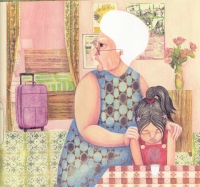| ________________
CM . . . . Volume XVIII Number 12 . . . . November 18, 2011
excerpt:
The little girl who narrates this story hasn’t seen her father in “one year, eight months and twenty-two days.” He is far across the ocean, working in the United States. While he is away, she fills journals with drawings and stories about the things she’s experiencing without him. She misses him greatly, and looks forward to her weekly phone conversations with him. Then she discovers that he won’t be returning – instead, she and her Mamá will be joining him in the United States. The little girl feels excited, but also sad to leave her friend, dog, and Abuela (grandmother) behind. She works through these conflicting emotions until she’s finally on the plane. Then she begins a new journal – but this one is for her Abuela. 
Picture books that deal with the subject of moving are fairly common, but Schimel’s story is different in several ways. For instance, Let’s Go See Papá! additionally deals with absent family members. The girl’s father is away, but, for the girl to be with him, she must leave her grandmother behind. Schimel does not gloss over the girl’s sadness, but the conclusion remains upbeat and hopeful nonetheless. The lack of permanence in this book is also unique. In most stories about moving, there is a single, permanent destination. Here, the girl’s father is away for an unspecified amount of time. While the girl is going to join him in the United States, her family does plan to return to their home eventually. This uncertainty adds to the realism of the story. The narration also adds to the authenticity of this story: the phrasing and figures of speech sound like a genuine little girl’s. For instance, she wants to write in her journal, but for the first time, she doesn’t know “what to put down.” The night before her flight, she can’t sleep: “I feel like my tummy is full of squirrels jumping around. … But I guess I slept a bit, because suddenly Abuela is calling me for breakfast.” The little girl is smart and thoughtful, and it will be easy for children to identify with her. Alba Marina Rivera’s illustrations also set this book apart. Her beautiful art captures the personality of the little girl and the beauty of her home. The detailed illustrations are sometimes paired with the little girl’s drawings in her journal, with the latter looking very genuine. Whether they were actually drawn by a child is not noted, but the erased pencil lines and childlike style add a lot of charm. The other illustrations are rich in detail. For example, after hearing that she’ll be moving, the little girl leans in her window and looks out at the dark street. Her window is the only illuminated area in the picture. Around the corner, two people are visible, sitting under a weak streetlamp. The mood of this image enhances the feelings of sadness and confusion described in the text. Other illustrations play with limited colour and stark lines, creating visual interest. A tree in front of the little girl’s house is often featured in the illustrations, and the pretty red flowers that grow on it appear in the house, scattered on a table. Near the end of the book, the little girl is shown saying goodbye to her dog, with the red flowers in the background. On the facing page of text, a small, stark illustration shows the nearby bench covered in flowers. Almost unnoticeable, a tiny hand reaches in from the edge of the page and plucks a flower from the bench. In the final two pictures of the little girl leaving her home, the flower is securely pinned behind a clip in her hair. This detail shows that, although she has left her family behind, a piece of her home is coming with her. The honest and compelling text, combined with rich and charming illustrations, make Let’s Go See Papá! an essential for collections. Highly Recommended. Katie Edwards is a Special Librarian with the Calgary Health Trust in Calgary, AB.
To comment
on this title or this review, send mail to cm@umanitoba.ca.
Copyright © the Manitoba Library Association. Reproduction for personal
use is permitted only if this copyright notice is maintained. Any
other reproduction is prohibited without permission.
NEXT REVIEW |
TABLE OF CONTENTS FOR THIS ISSUE
- November 18, 2011.
AUTHORS |
TITLES |
MEDIA REVIEWS |
PROFILES |
BACK ISSUES |
SEARCH |
CMARCHIVE |
HOME |
